 Imperial Japanese Navy Fleet Light Aircraft Carrier
Imperial Japanese Navy Fleet Light Aircraft CarrierWW2 IJN Aircraft Carriers:
Hōshō | Akagi | Kaga | Ryūjō | Sōryū | Hiryū | Shōkaku class | Zuihō class | Ryūhō | Hiyo class | Chitose class | Mizuho class* | Taihō | Shinano | Unryū class | Taiyo class | Kaiyo | Shinyo | Ibuki |IJN Ryūjō was a light IJN carrier of 8,000 metric tons displacement designed to exploit Washington treaty’s limitations loopholes under 10,000 tonnes. Contrary to her style, narrow with a cruiser bow and no island, she was not a converted cruiser but was designed in effect. However the would remained the only one, as the loophole was addressed by the 1930 London treaty. Despite of this, she carried 48 planes and served alongside Kaga, Akagi and Hosho during the Sino-Japanese war, with the feared Kido Butai. She was very active in WW2, participating in the Philippines, Malaya, and the Dutch East Indies campaigns, Second Battle of the Java Sea, Indian Ocean raid, Battle of the Aleutian Islands, but met her fate in the Battle of the Eastern Solomons on 24 August 1942.
Development of a cheating Japanese light Carrier
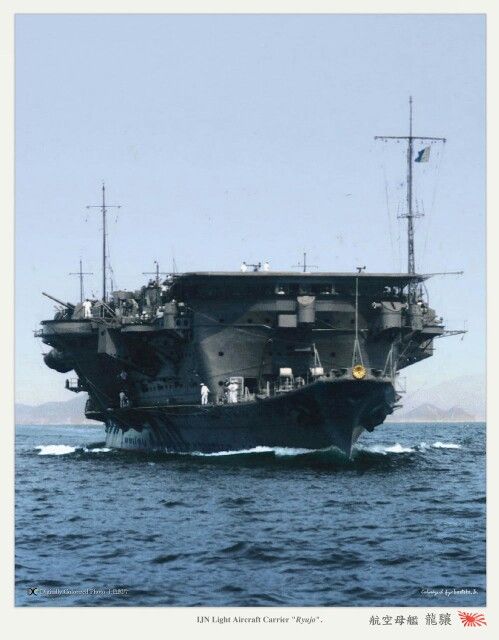
Colorization of IJN Ryujo, bow view, by irootoko jr.
The Imperial Japanese Navy Ryūjō was planned already in 1926 as a light carrier of circa 8,000 metric tons (7,900 long tons) in standard displacement to play with the Washington Naval Treaty of 1922. The latter indeed stated that under 10,000 long tons of standard displacement a ship carrying planes was no longer regarded as an “aircraft carrier”. Seeing an opportunity the admiralty at that time wanted to create a serie of standard, light fleet CVs and several designs were studied.
IJN Ryūjō construction was eventually voted and started with the laying down of her keel at Mistubishi Yard in Yokohama, on 26 November 1929. The global market crash and ensuing economical crisis did not affect her but in between a Japanese delegation signatory of Washington was also sigatory of the follow-on London Naval Treaty of 1930. It had a newly added Article Three, specified aicraft carriers below 10,000 tons whould also be limited and feiniong a global tonnage. This closed the aforementioned loophole and therefore, the IJN was found capped in this area. Therefore, IJN Ryūjō remained the only light aircraft carrier of this type. When light CVs were created afterwards, they were all escort vessels converted from existing hulls. This made IJN Ryūjō a singular vessel with some design issues and far less plans onboard than Kaga or Akagi, although Japanese doctrine did not stressed large air groups as much as in the USN in the early 1930s.
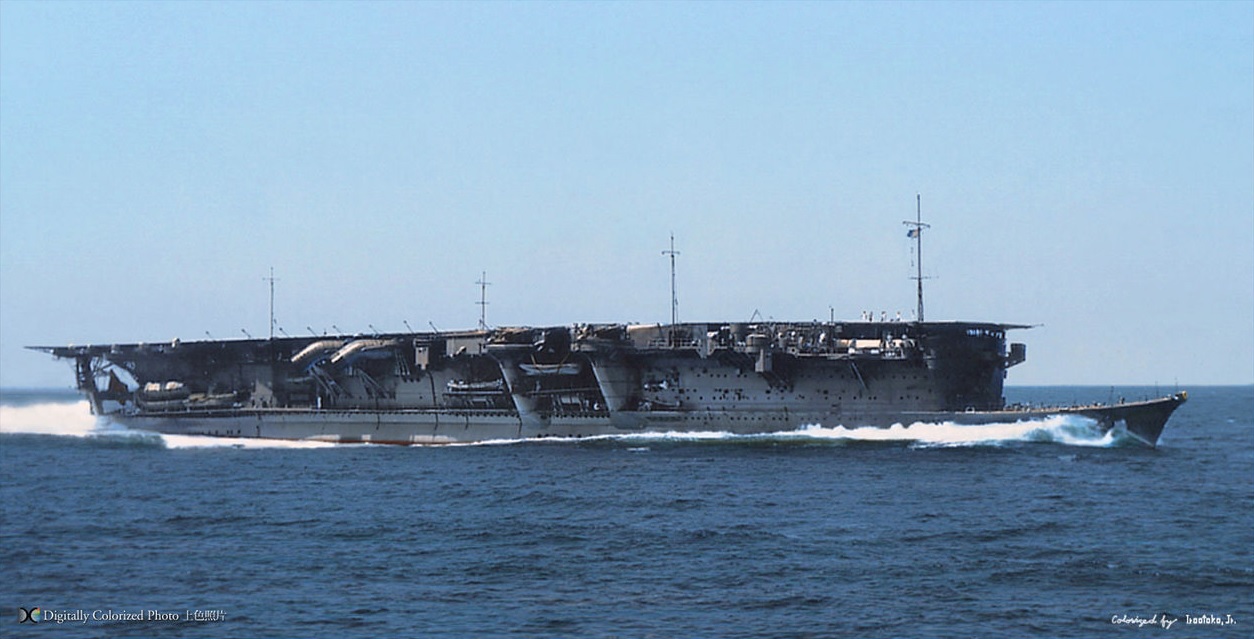
Colorization of IJN Ryujo in 1936 by irootoko jr.
Design of IJN Ryūjō
Ryūjō was planned as a “light carrier” targeting 8,000 metric tons of standard displacement to exploit the Washington Naval Treaty disregarding any vessel below 10,000 tons as an “aircraft carrier”. Ryūjō was already under construction, when the London Naval Treaty making this illegal. In the end, Ryujo was designed over a light cruiser hull, and was only 179.9 meters (590 ft 3 in) overall, with however a larger beam of 20.32 meters (66 ft 8 in) at the waterline, so almost 1/9 ratio, because of stability concerns and having a sizeable hangar above. It had a a draft of 5.56 meters (18 ft 3 in). At the end of the design, confirmed by construction, her displacement was calculated at 10,150 metric tons in normal load. Her crew was about 600.
Hull & protection

Construction in Yokohama in 1931
Ryūjō’s low weight dictated a lightly built hull and no armor but some protective plating over the most sensible parts: Abreast the machinery spaces and magazines, and this was mostly splinter decks, with around 10-15 mm protection (0.4-0.6 in) with high-tensile steel. Also contrary of previous conversions, she was built with a single hangar, which also helped to keep her overall height limited. However the initial planned an extremely low profile (4.6 meters (15 ft 1 in) freeboard amidships, just 3.0 meters (9 ft 10 in) aft), similat to the later Zuiho class. However during the time she was laid down in 1929 and launched in 1931, the admiralty wanted double the amount of aviation onboard, and the stowage requirement, around 28 planes, turned to 48 for a more capable air group. Games helped the admiralty to reach the same conslusion than their American counterparts.
But this soon became an engineer’s nightmare, while the ship was already in construction. Their only solution was to built another hangar atop the first one, deck level. It raised the freeboard to 14.9 meters (48 ft 11 in) but since the hull still had the same narrow beam, she became hardly stable in rough seas as calculated. In all her flight deck was 3,600m² (38,750 ft square) in surface, with a lenght of 156.5 m and a width of 23.0m (111 x 75 feets). Her upper and lower hangars were served by two lifts or unequal size and shapes: One fore was 11.1 m x 15.7m (36 x 51 feets) and the one aft made 10.8 m x 8.0m (35 x 26 feets).
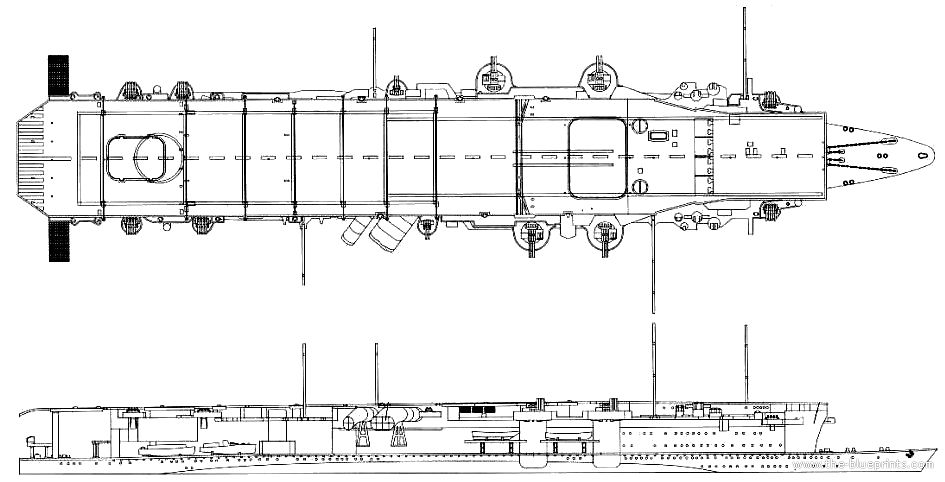
Profile As completed, 1933F (ctds navypedia)
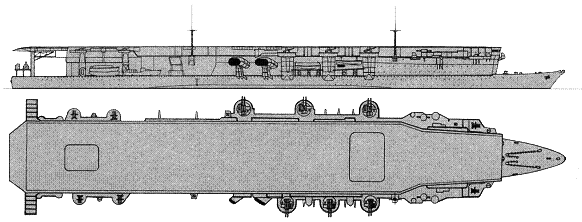
Profile in 1936

Profile in 1940
First refit, 1934
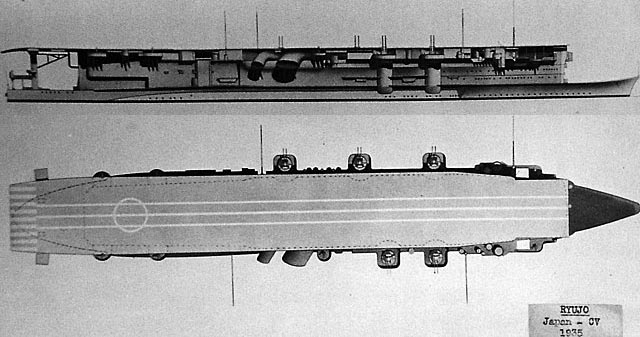
1935 ONI depiction of the ship (library of congress)
The first act was to add Sperry active stabilizers, but her hull needed both strenghtening and additions. In between, the famous Tomozuru Incident of 12 March 1934 (a latter demonstrated top-heavy torpedo boat capsized and broke in two in heavy weather) had the admiralty reconsider its ship’s stability across the board. In June-September 1933, IJN RYUJO made her sea trials and training at 29 knots and soon problems appeared: She was very, very wet, even under under moderate sea conditions. She was indeed plowing heavily enough for her front hangar so seep in massive quantities of seawater, while she rolled and rcked quite heavily, showing a clear lack of stability.
On Ryūjō, this meant massively increasing hull strength. So as soon as she was in service, she went back to Kure Naval Arsenal for modifications. Engineers worked out her keel notably, adding ballast, mounting shallow torpedo bulges and raising the waterline (so her draft). On another note, recent lessons from aicraft carriers in service urged in the same refit to have her funnels were moved higher up curved downward, in order to keep smoke away from the deck. Also it was made clear her flight deck ineffective as her small areas did not allow to carry proper runway operations with more than six aircrafts simultaneously (with the new generation of aircraft especially), severely hampering her air group.
Second refit, 1936
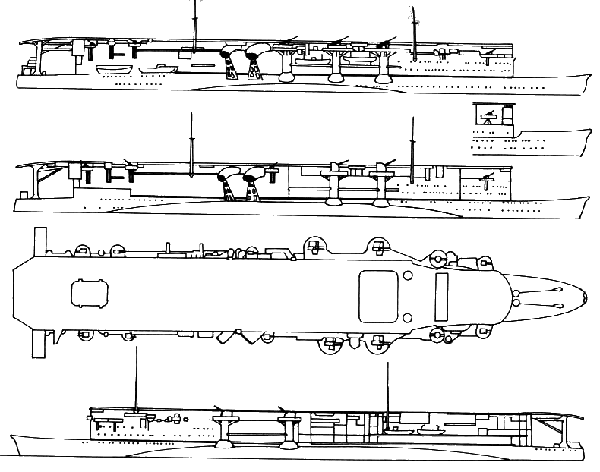
Refits profiles history 1933-42
Was that sufficient ? Soon, IJN Ryūjō was caught in a typhoon, on 25 September 1935, while maneuvering. This became the “Fourth Fleet Incident”, in whih many vessels were lost. Her bridge, flight deck and superstructure were all damaged by massive waves and her hangar flooded and devastated. During another refit, her forecastle was completely rebuilt to avoid being submerged. It was raised from one entire deck while her bow was remodelled. She had more flare to sea handling, whereas both beam increased, up to 20.78 meters (68 ft 2 in) while her draft ended at 7.08 meters (23 ft 3 in), displacement now jumped from 10,600 to 12,732 metric tons, way above the former Washington limit. The crew grew to 924 officers and enlisted men to serve the additional planes and AA. Also her flight deck had roounded edges, wider aft but shorter by 2 m (6.5 ft), new arrestors cables were set in place to stop 6,000-kg (13,000 lb) aircraft, bridge modified (rounded). This was over in May 1936.
3rd and 4th refits 1939-42
She was refitted again in 1939, (starting 15 November) in Kure, until January 1940 with various repairs, fixes and a redesign of her flight deck: It was narrower back as in the original design width, starting from a postion approx. the forward 12.7-cm (5.0”)/40 Type 89 gun mount and forward elevator.
Her last refit was On 28 April 1942, also for maintenance after extensive service. This mostly consisted in a massive AA upgrade. It was completed in May 1942, her six-quad Type 93 13.2 mm MGs replaced by six-triple Type 96 25mm guns, in addition to her amidships two-twin Type 96.
IJN Ryujo’s Refits in brief:
- 1934: Bulges, ballasts, strenghtening, funnels modified.
- 1936: Modified hangar, beam, draft, arrester wires, modified flight deck.
- 1939: Forecastle raised, Modified flight deck
- 1942: AA additions
Powerplant
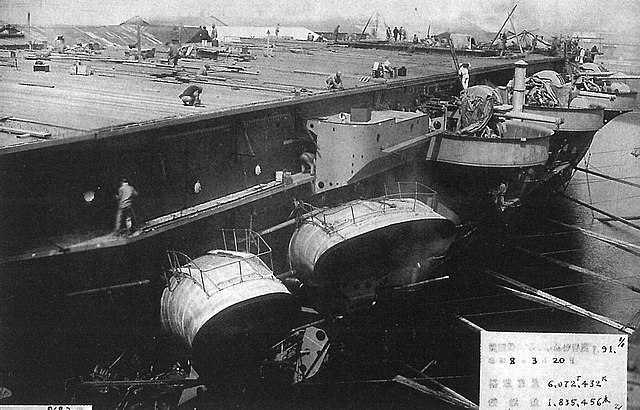
Close view of the Funnels after completion

Myoko turbine set configuration
Ryujo was given basically the same powerplant as the Myoko class heavy cruisers but scaled down: Two geared steam turbine sets producting a total ouptut of 65,000 shaft horsepower (48,000 kW) with its own propeller shaft. They were fed by the steam provided by six Kampon water-tube boilers. Ryūjō’s design speed was 29 knots (54 km/h; 33 mph), but she reached 29.5 knots (54.6 km/h; 33.9 mph) on sea trials, with a total output of 65,270 shp (48,670 kW). For long range operations in the pacific she carried 2,490 long tons (2,530 t) of fuel oil for 10,000 nautical miles (19,000 km; 12,000 mi) at 14 knots (26 km/h; 16 mph). Her boilers uptakes were trunked to her starboard side amidships, exhausted horizontally below the flight deck level with two small funnels. Tests were made to improve both gases extraction and avoid smoke interfecrence problems, an issue dealt with since Hosho in 1919.
Armament
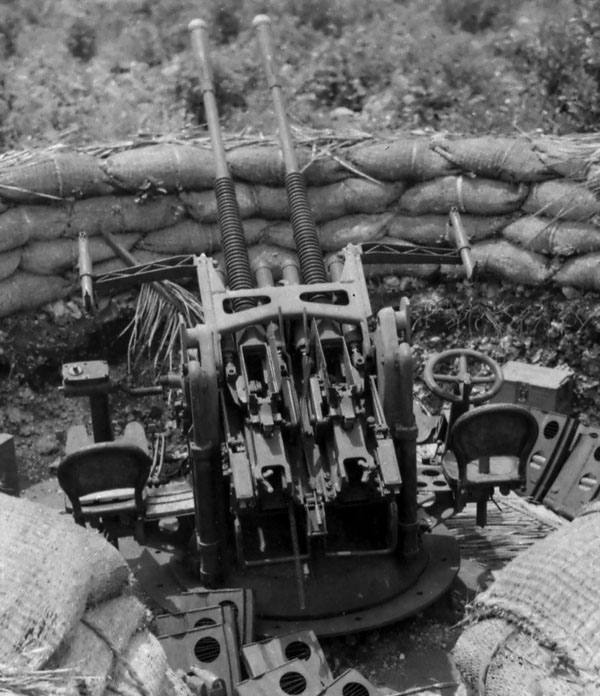
25 mm Type 96 AA
-Six twin-gun mounts, three per side, equipped with 40-caliber 12.7-centimeter Type 89 dual-purpose guns. They were mounted on projecting sponsons, but high enough t cover the other side of the flight deck. Lessons were learned since the conversion of Kaga and Akagi. Range: 14,700 meters (16,100 yd), ceiling of 9,440 meters (30,970 ft), rate of fire 14 rpm, 8 sustained. The twenty-four anti-aircraft (AA) Type 93 13.2 mm Hotchkiss HMGs were also in sponsons along the flight dekc in twin and quadruple mounts. As a short range weapons they dealt with planes approachinag at 700–1,500 meters (770–1,640 yd) and capable of a 425 and 475 rpm on paper, but loading the 30-round magazines made a real 250 rounds per minute ratio.
The 1934–36 refit, saw two of the 5.0 in mounts exchanged for two twin-gun Hotchkiss 25 mm Type 96 light AA guns instead, largely required to reduce toweight (this saved circa 60 long tons) and improve stability. The 25 mm had severe design shortcomings and was largely ineffective. It was mostly the result of a slow-moving mount and could not be trained or elevated fast enough. Also sights were inadequate for high-speed targets. It was also plagued by vibration problems and the crew was blinded by the muzzle blast. These could still provided a larger defensive bubble, at 1,500–3,000 meters (1,600–3,300 yd) with a ceiling of 5,500 meters (18,000 ft) but a 110-120 rpm cycle due to the use of manually loaded fifteen-round magazines.
- 6×2 127 mm (5-in) AA
- 24x 13.2 mm Hotchkiss AA (4×4, 4×2)
- After May 1942: 6×3 25 mm AA
Air group
For her sea trials she already had a relatively small air group (making also flying qualifications), consisting of 9 Mitsubishi Type 13 B1M2 (+3 spares) attack aircraft and 3 Nakajima Type 3 (+2 spares) A1N1 fighters. They was plenty of room in both hangars for more. On December 1933 this comprised 5 A1N2 and 12 B1M2, and an unknown number of other models. In Jylu 1937 her air group comprised for certain 12 Nakajima A2N and A4N, and 15 D1A2, plus again, unknown complement. After her third refit, when the war broke out wit the US in December 1941 the air group comprised 22 A5M4 “Claude” fighters and 16 B5N2 “Kate” torpedo bombers. In August 1942 after her fourth and last refit, she carried 22 A6M2 “Zeke” and 6 B5N2 “Kate”, showing she was used a bit like the USN Independence class as a “fighter carrier” with a symbolic strike air group.

Nakajima B5N1 “Kate”, 4th Koku Sentai, Ryujo, 1941
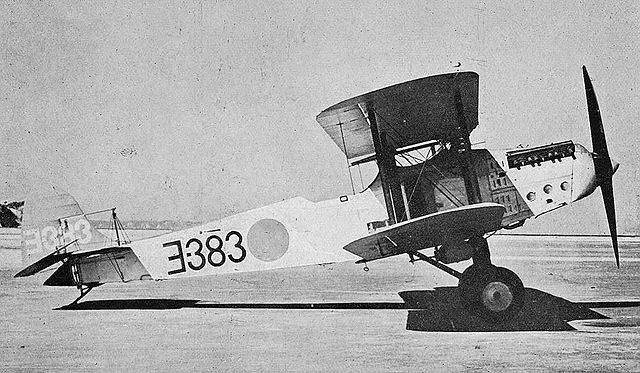
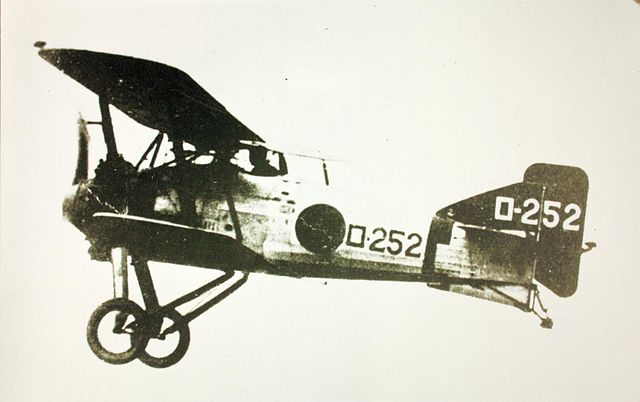
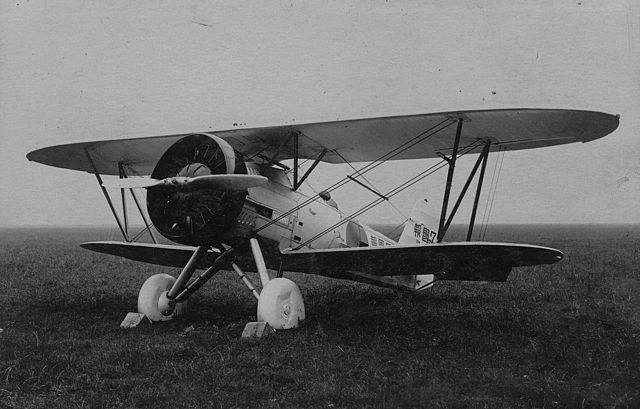
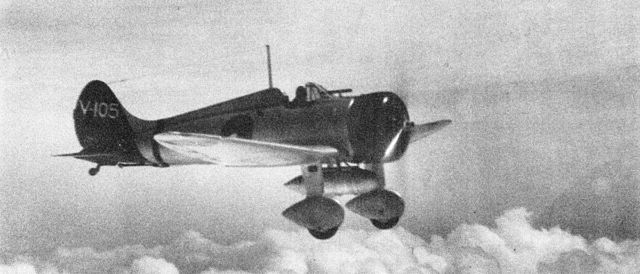
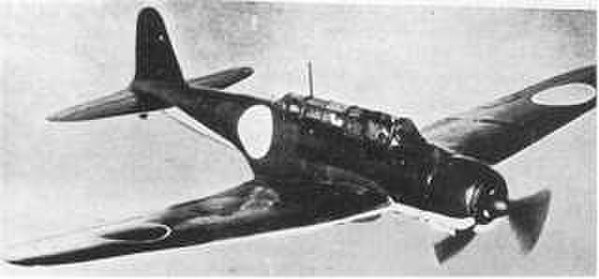
Mitsubishi B1M2, Nakajima A1N1, Nakajima A2N & A4N1, Mistubishi A5M2 “claude”, Nakajima B5N2 “Kate”
Facilities
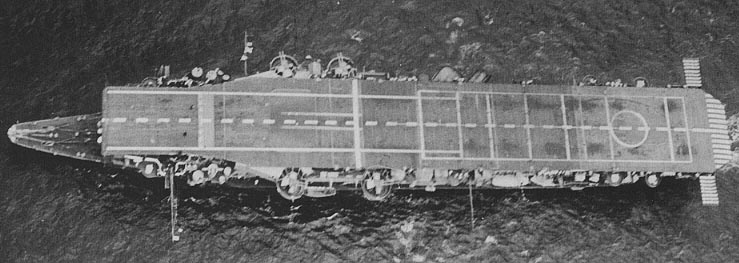
Flight deck in 1936
IJN Ryūjō had no island superstructure to avoid interference in deck operations, so her navigating and control bridge was situated just under her flight deck forward “lip”. There was a long “greenhouse”. Its wall was curved and sloped downards, set back 23.5 meters (77 ft 1 in) from the stem, making an open bow. With 156.5 m x 23 m (513 ft 5 in x 75 ft 6 in) her flight deck extended well beyond the aft end of the superstructure. It was supported by two pillars aft. The aft deck was criss-crosse dby six transverse arrestor cables. In 1936 they were swapped for much stronger models able to stop a 6,000 kg (13,000 lb) aircraft. The two hangars measured 102.4 meters (335 ft 11 in) long overall for 18.9 meters (62 ft 0 in) in width (3,871 square metres, 41,667 sq ft). Although there was no room to store an aircraft under the ceiling, but only parts, both could store 24 aircraft in all, making a total of 48, but 37 could operated, many were jus stored replacements. Ryūjō’s bridge flight deck leading edge were were rounded off, streamlined for heavy weather, reducing the flight deck lenght, but modified again later. The aircraft were brought to the flight deck using two elevators, one forward (15.7 by 11.1 meters, 51.5 ft × 36.4 ft) one aft (10.8 by 8.0 meters, 55.4 ft × 26.2 ft). The latter appeared too small and unable to deal with the latest torpedo planes of the IJN, and was only use to brinh up fighters or supplies. However the Nakajima B5N “Kate” torpedo bomber could still barely fit at an agnle wings folded on the forward one. This single-elevator capability gravely hindered transfer of her air group, notably for rearming and refueling.

Author’s profile of IJN Ryujo
⚙ 1940 Specifications |
|
| Displacement | 10,600 long tons, 13,450 long tons FL |
| Dimensions | 179.9 m oa x 20.8m x 7m ( x 23 feets) |
| Propulsion | 2 shafts Kampon geared turbines, 6 Boilers, 65,000 shp () |
| Speed | 29 knots (55 km/h; 34 mph) |
| Range | ? nmi () at 15 knots (28 km/h; 17 mph) |
| Armament | 4×2 5 in (127 mm), 4x 25 mm AA, 48 aircraft |
| Armor | See notes |
| Crew | 924 |
Read More/Src
On navypedia
On combinedfleet.com
wiki
Full service records on combinedfleet.com
On wrecksite.eu
On global sec.
On the pacific war online
On pacificwrecks.com
On mil. factory.com
Video
The models corner

Chibimaru Ship Series Ryujo Fujimi 1:Egg 42204
IJN Aircraft Carrier Ryujo After the First Reconstruction DX Fujimi 1:700
IJN Aircraft Carrier Ryujo Second Refit (with 33 Navalised Aircraft / Second Battle of the Solomon Sea) Fujimi 1:700
Aircraft Carrier Ryujo SD Aoshima 1:700
Aircraft Carrier Ryujo Second Upgrade Aoshima 1:700
Aircraft Carrier Ryujo (Battle of The Eastern Solomons) STD Waterline Series No. 230 Aoshima 1:700
IJN Aircraftcarrier Ryujo (2.upgrd) Flight Deck Tetra Model Works 1:700
IJN Ryūjō in action:
Early career (1933-37)
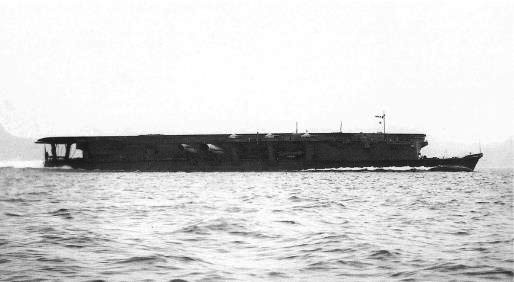
Ryujo in trials, 1933
Laid down at Yokohama on 26 November 1929 in Mitsubishi Heavy Industries Dockyard, Ryjo was launched on 2 April 1931. her named signified “Prancing Dragon”. On 25 April 1931 she was towed to Yokosuka Naval Yard for fitting-out. On 1st December 1931, her first captai (later Rear Admiral) Matsunaga Toshio took command. He was formerly on the IJN AKAGI, as Chief Equipping Officer for the completion. On 9 May 1933, IJN Ryujo was at last commissioned and Captain Matsunaga was appointed as Captain, for her sea trials, which took place between June and September 1933, followed by training exercises for her air group. It comprised at the time 9 Mitsubishi Type 13 B1M2 and 3 Nakajima Type 3 A1N1 plus spares, and the ship conducted launches and recuperations at 29 knots to see if practicable. However it soon was found the ship was wet under moderate sea conditions, particularly from the bow. She also dangerously lacked stability, rolling and rocking badly. Se then team trained with Hosho in Ise Bay.

Underway, 6 Sept. 1934
On 20 October 1933 Captain Matsunaga is relieved by Captain Kuwabara Torao and on 12 March 1934 took place the Tomozuru incident, which triggerred a committee to inspect stability of all IJN vessels. On 26 May 1934, Ryujo entered Kure Naval Yard for a refit and modifications, until 20 August 1934. Until October 1934 she made post-refit trials showing still seaworthiness limitations. her new air group cormprises 9 Mitsubishi B1M2, 6 Nakajima A1N1, 6 Nakajima A2N1. On 15 November 1934 CaptainOno Ichiro (formerly foremerly on KAGA) takes command and the carrier start a flagship career under Rear Admiral Wada Hideho and his CarDiv 1 (Ryujo, Hosho, and DesDiv 5).
By December 1934 Rujo tests qualifications flights for carrier-based dive-bombing tactics with 6 (+2 spares) Nakajima 90 E4N3-C bombers and 6 Yokosuka Type 92 B3Y1 plus 12 Nakajima Type 90 A2N1 fighters and spares. It’s its largest air group so far. By February 1935, the tests ended and the E4N3-C is rejected as too fragile for the task. Soon the Aichi D1A1 replace it and is also intensively tested from Kure Naval Base, becoming in effect the fist true Japanese dive-bomber. By September 1935 Ryujo’s CarDiv 1 took part in the first large Combined Fleet’s Great Manoeuvers, as part of “Red Fleet in the NW Pacific, as far as the Kuriles. On 25 September 1935 takes place the “Fourth Fleet Incident”, a massive storm off Hokkaido. Both Ryujo, Hosho, several cruisers and destroyers suffer extensive wave damage, Ryujo being heavily flooded as well.
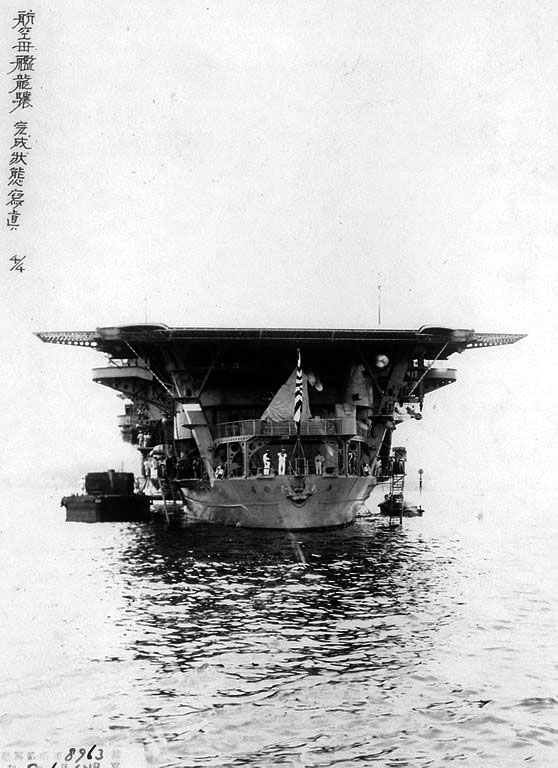
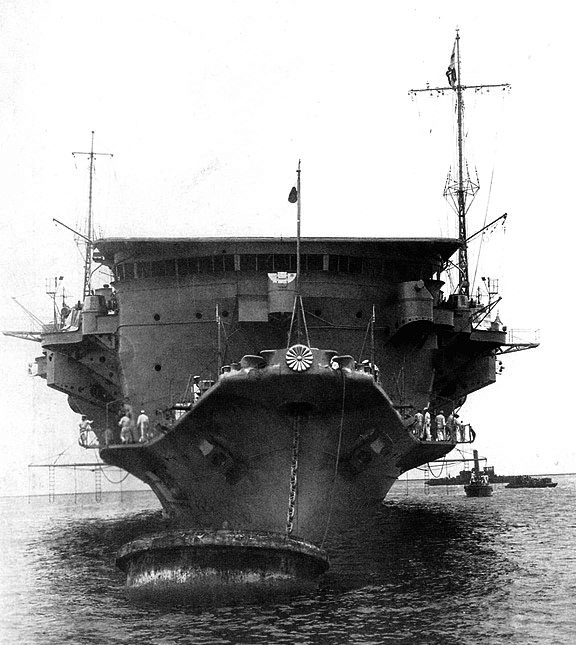
Stern and bow in 1935
On 11 October 1935 she entered Kure’s drydock for repairs, and modifications from October 1935 to May 1936 while Captain Kira Shunichi takes command as captain. In June-August 1936 she made her post-refit trials, confirming she met her seaworthiness objectives in all conditions. She returned to bomb-diving tactics exercises, with 12 (+4 spares) Aichi Type 94 D1A “Susy” bombers, all satisfactory. She also carried as complement 24 (+8 spares) Nakajima A4N1 fighters, so 36 total, a far cry to her theoretical 48.
By September 1936 she returns as flagship (but under Rear Admiral Sato Saburo) CarDiv 1 with Hosho, and her air group is modified again to comprise also Yokosuka Type 92 B3Y1 and Nakajima Type 90 A2N1, now close to 48. On 29 October 1936 fleet maneuvers near Kobe are so successful the admiralty decided to make RYUJO a specialist in dive-bombing but nebertheless she was seen as a training carrier for such operations and her dive bombers are transferred to other carriers. On 16 November 1936 Captain Abe Katsuo takes command and on 7 July 1937 it’s the The Marco Polo Bridge Incident, marking the start of the Sino-Japanese war.
Sino-Japanese War (1937-41)
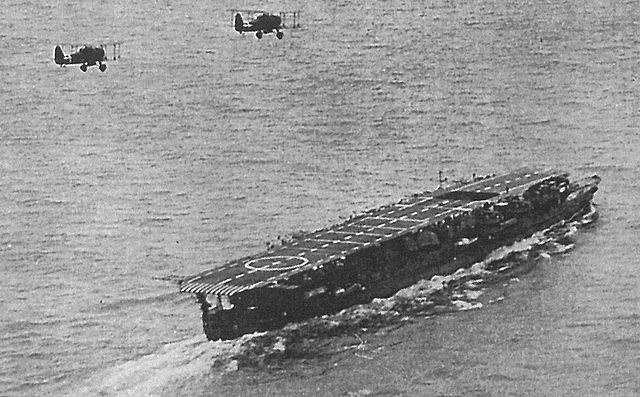
Ryujo in China, 1935
On 11 August 1937 CarDiv 1 departs Sasebo for China and arrived off Shanghai on 13 August 1937, soon joining CarDiv 2’s (Kaga, Akagi) in the East China Sea under overall orders of Vice Admiral Hasegawa Kiyoshi (3rd Fleet) for air supporting during ground operations in central China and along the coast around Shanghai. In total 80 carrier-based planes are used, Ryujo committing 15 D1A1 bombers and 12 A4N1 fighters. On 16 August 1937 a major joint strike is launched again Chinese airfields near Shanghai. Ryujo in particular destroys Hia-King Airfield NW of Shanghai but they are intercepted by Chinese Curtiss Hawks IIIs, shooting down two for no loss. Another raid targets a railroad bridge between Shanghai and Sou-Tcheou, but aborted due to bad weather conditions.All along August 1937, operations targets the Chinese HQ building located in Shanghai, Ten-Ji College, Cha-Hsing Airfield, shooting down 5 Hawks near Pao-Shan and later the same plus Boeing 281 , claiming 2. Next artillery troops barracks NW of Shanghai is bombed, but a biomber is lost. On 1st September 1937, Ryujo departs for Sasebo to be resupplied with spare aircraft and ammunition, refueled, and back to the south chna sea on 21 September 1937, this time to operate near Canton. 12D1A1 escorted by 9 A4N1 attacked the city and are intercepted by Curtiss Hawk III, claiming six kills; and another later that day. On 22 to 30 September 1937 operations against Canton goes on, until departure to Shanghai.

Underway in September 1938
On 6 October 1937, her air group is relocated to Kunda Airfield for inland aerial protection between the Shanghai-Nanking area of operaton, and they are back on the carrier on 17 October 1937. By November 1937, Ryujo returns to Japan and by December CarDiv 1 is temporarily dissolved, followed by training in home waters, and arrival of Captain Okada Jisaku in command. In January 1938 she is attached to CarDiv 2 under Rear Admiral Mitsanumi Teizo (with IJN SORYU). In February she received her first Mitsubishi A5M4 “Claude” fighters and in March 1938 returnes in Chinese waters, around the Canton area, operating until 5 April 1938 in support of the offensive against Canton. In December Captain Kosaka Kanae takes command and she stays in position until 15 November 1939 when she departs for Kure, reserve for drydock modifications and maintenance, and passation to capt. Hasegawa Kiichi.
Until January 1940, Ryujo underwent, repairs, modifications of her flight deck, and until July 1940, she trained her crew and air group, practicing takeoff exercises with the 12th Combined Air Group. On 21 June Captain Sugimoto Ushie (on SORYU previously) takes command, and by November Ryujo returns as flagship, Rear Admiral Kakuta Kakuji (CarDiv 3), First Fleet with her old companion hosho and DesDiv 34. By that time, her air group was remodelled, with 18 B5N1 “Kate”, 16 A5M4 “Claude” but no dive-bombers, in part due to her mediocre aft elevator.
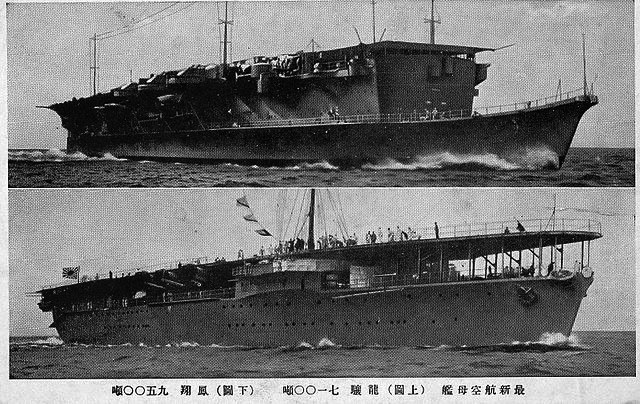
IJN Ruyjo and Hosho, for long together in the Carrier Division 3
On 10 April 1941 as the First Air Fleet is created, as Flagship (Rear Admiral Kuwabara Torao) CarDiv 4 she is now part of the famous “Kido Butai”, in Yokohama by April. In May she departs for Eniwetok in the Marshalls and for Kwajalein and back to Yokosuka. In June she was back in Kwajalein to reinforce the garrison and base, before proceeding to Truk, in the Central Carolines, then Saipan in the Marianas and return to Tokyo Bay. On 7 July and until October 1941 she trained in the indland sea with the rest of the 1st air fleet for upcoming operations. In between, Rear Admiral Kakuta took command of CarDiv 4.
Ryujo during WW2:
The Philippines Campaign
On 11 August 1941 with her new escort DesDiv 3 (Shiokaze, Hokaze) she trained extensively, and on 1st September Rear Admiral Kakuta takes command of CarDiv 4. On 22 October 1941, she departs for Takao in Formosa and later and Mako in the Pescadores. In November, she is in Kure and tactically assigned to Southern Philippines’s Air Attack Force. She departs Saeki for Koror in the Palaus. On 2 December 1941 she receives the famous signal “Climb Mt. Niitaka 1208” from the Combined Fleet on the start of hotilities on 8 December. On the 5th, her air group is now complete for operations, with 12 (+4 spares) Mitsubishi A5M4 “Claude”, 14 (+4 spares) Nakajima Type 97 B5N “Kate”, so 34 planes. On 6 December 1941 she took part in Operation “M”, the Attack on the Southern Philippines. Indeed with Hosho she was found a bit slow with a small aor group, too much to be attached to the Kido Butao for the attack on pearl Harbor. Instead, she would speahead the invasion of the Philippines, from the Palau. First, she covered the landings at Davao and Legaspi under Vice Admiral Takahashi Ibo third Fleet, Southern Force. In addition to her destroyer escort, she was also given CruDiv 5 (Nachi, Myoko) and Rear Admiral Tanaka Raizo’s attack group led by the light cruiser Jintsu and DesDiv 15, DesDiv 16 destroyers units.
She supported operations by launching sorties against objectives in Davao and Mindanao on the morning of 8 December. Ryūjō’s first airstrike comprised 13 B5Ns, escorted by nine A5Ms. She lauinched another wave later that day, with just two B5Ns and three A5Ms. Apart destroying two Consolidated PBY seaplanes on the ground they did little, and one B5N, one A5M were lost to AA fire and aviation. During the landing at Davao on 20 December, she coverred operations with her B5Ns attacking a British oil tanker. In January 1942, she started a round of operation in the Malay Peninsula.
Indian Ocean Operations (Jan-March 1942)
By mid-February 1942, during the erly phase against Singapore (Long after Force Z has been destroyed), she launched patrols to spot and strike evacuating ships from Singapore. Her air group claimed eight ships damaged, three burnt, four sunk. Her planes also covered convoys of troopships to nearby Sumatra. The aicraft carrier was attacked by a wave of Bristol Blenheim (No. 84 Squadron RAF) on 14 February, but all missed. In retaliation, two waves of B5Ns (13) attacked HMS Exeter, previously spotted, but they mostly missed. Only damage was the onboard Supermarine Walrus seaplane. Another wave followed that day, also without hit. Two days later however Ryujo’s B5Ns sank the Dutch destroyer HNLMS Van Ghent which ran aground in the Gaspar Strait, abandoned two days prior (so no human losses). Operations over Saigon in French Indochina followed, from 20 February. IJN Ryujo was stationed off Saigon for a week and later she sailed to cover a troopships convoy to Jakarta for the occupation of Java. Her air group participated in the Second Battle of the Java Sea on 1st March 1942. Six B5Ns sank the destroyer USS Pope, after evacuation. Six others bombed Semarang harbour, and destroyed a merchantman.
Malaysia-Burma campaign (March-May)
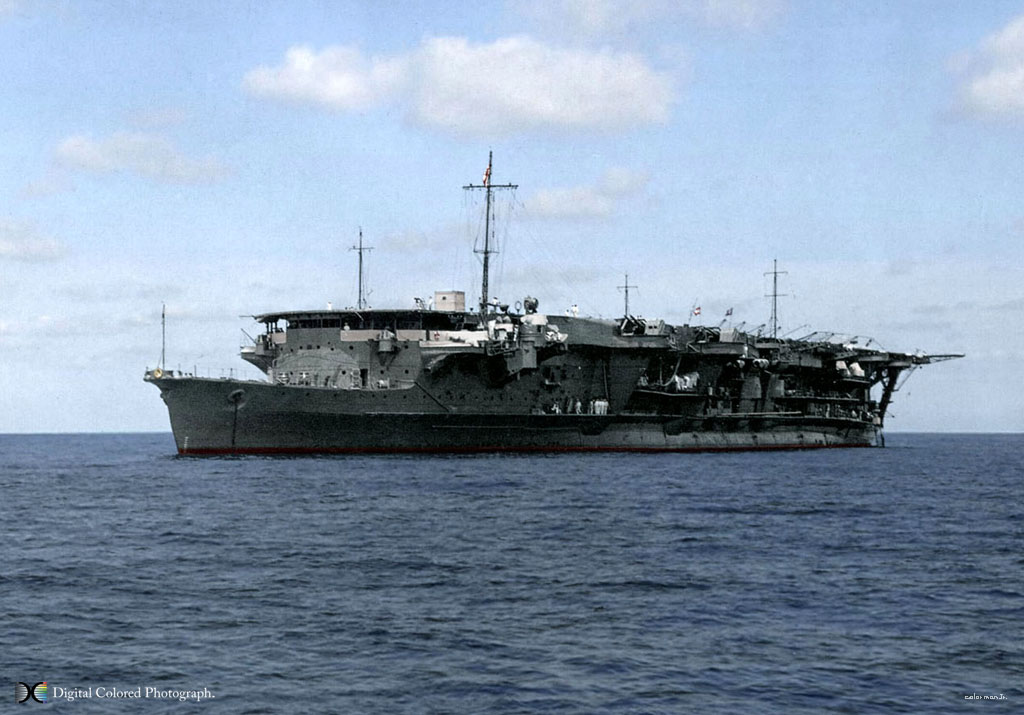
IJN Ryujo, colorized by Irootoko Jr.
IJN Ryūjō was back in Singapore waters on 5 March, to support landings in Sumatra, convoys to Burma and the Andaman Islands. On 1st April the Japanese admiratlty decidd to gather all the 1st Air Fleet for a major raid in the Indian Ocean. The “Malay Force” was established, consisting of IJN Ryūjō as its centerpiece, six cruisers and four destroyers. This force left Burma to attack merchant shipping in the Bay of Bengal. Her B5Ns damaged one on 5 April, but not finidng enough targets meant the force soon split into three groups. Ryūjō’s aviations bombed and strafed the ports of Cocanada and Vizagapatam (southeastern coast of India) but damage was light, no ship reported sunk. However later that day her her group claimed two freighter sunk, six damaged. Escorted by IJN Yura and Yugiri she also co-claimed three more ships (by gunfire). Malay Force in all, sunk 19 ships (circa 100,000 GRT). On 11 April it was back to Singapore and on the 18, B5Ns started torpedo training. Later on the 23, the carrier was back at Kure for a well-deserved maintenance and a short refit. In April also, Captain Sugimoto is relieved by Captain Kato Tadao, formerly on AKAGI. She was her last captain, but survived her (see later).
Aleutians campaign (Summer 1942)
IJN Jun’yō, newly commissioned, joined Carrier Division 4 (Rear adm. Kakuta), teaming with IJN Ryūjō on 3 May 1942. This became the core of the 2nd Carrier Strike Force, Northern Force. It was tasked to attack the Aleutian Islands. This was to provide advance warning in case of an American attack from the Aleutians, targeting the Japanese Kurile Islands during the operations around Midway. Ryūjō at that time after her refit in Kure where her AA was bolstered, gained new fioghters, 12 A6M2 Zeros, while retaining her squadron of 18 B5Ns (two spares for each, so 34 planes in all). She arrived in Mutsu Bay on 25 May before heading for Paramushiro on 1 June and then proceed to ht e long trip north to the Aleutians.
At dawn on 3 June, nine B5Ns took off escorted by six Zeros. Their objective: Dutch Harbor, Unalaska Island. One B5N crashed on takeoff, but the rest wet through the appealingly bad weather, and soon spotted and destroyed two PBYs. They blasted oil storage tanks, barracks and facilities on the harbour. The carrier launched a second airstrike later that after a group of US destroyers has been spotted by aircraft from the first wave. They were never found again. One Zero was damaged by a Curtiss P-40, crash landing on Akutan. Crucially, it was late captured by US Forces, largely intact, bringing considerable intel to US Forces during the war. Repairs and tested, its determined weak points helped to devise better tactics to US Pilots, participating in turning the situation in the Pacific. On 4 June, Ryujo and Junyo launched a combined airstrike (15 Zeros, 11 D3As, 6 B5Ns) against Dutch Harbor again. However in between, the Americans attacked both carriers with aviation. A single Martin B-26 Marauder, a PBY and a B17 (By AA) were shot down by Zeros from their combined CAP.
Ryūjō then sailed back to Japan, Mutsu Bay, arriving on 24 June for resupply. She departed for the Aleutians on the 28, covering a troopship convoy to Attu and Kiska. She covered them until 7 July to prevent any counterattack. She was back in Kure on 13 July, this time for a comprehensive refit, before transfer to Carrier Division 2.
Battle of the Eastern Solomons
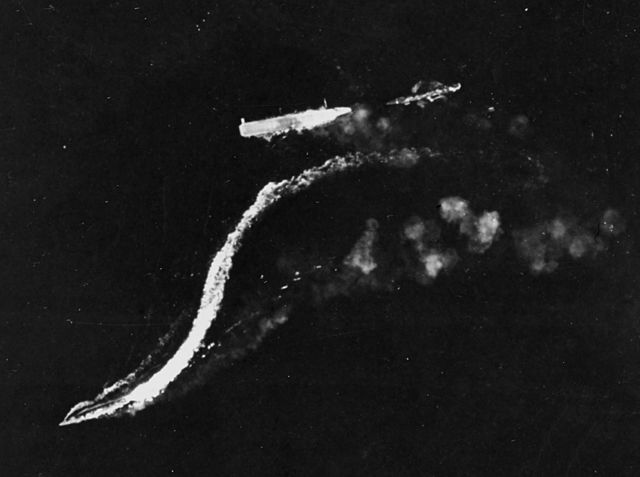
A disabled Ryūjō (top center) under attack from high altitude, by B-17 bombers on 24 August 1942: IJN Amatsukaze (lower left) is moving away from Ryūjō at full speed and Tokitsukaze (faintly visible, upper right) is backing away from Ryūjō’s bow while bombs are raining.
Landings on Guadalcanal and Tulagi on 7 August saw Ryūjō transferred hastily to bolster Carrier Division 1, departing for Truk on 16 August and teaming with Shōkaku and Zuikaku, the remanant of the decimated Kido Butai, absent at Midway. Her air group of 24 Zeros, nine B5N2s plus spares was made ready tio take order under Admiral Isoroku Yamamoto, C-in-C of the Combined Fleet. In fact Truk was bypassed and the fleet headed towards a spotted USN CV off the Solomon Islands on 21 August. On 24 August during the night, Nagumo (Mobile Force) ordered Ryūjō and Tone plus two destroyers to head in advance of the troop convoy, attack Henderson Field if no carriers were spotted. This detached forced was under orders of Rear Admiral Chūichi Hara (onboard Tone). Ryūjō launched two small airstrikes (6 B5Ns and 15 Zeros each) from 12:20 from 200 nautical miles off Lunga Point (north). Four Grumman F4F Wildcat (VMF-223) near Henderson Field spotted them and alert was given at 14:20. Ten Wildcats from VMF-223, VMF-212, two USAAF Bell P-400s (67th FS) took off and soon spotted and engaged Ryujio’s Zeros, nine of them already strafing the airfield, B5Ns bombing the airfield with small 130 lb bombs. Despite claims of 19 shot down, the Japanese lost three Zeros, three B5Ns, another later crash-landing, but claimed three Wildcats.
At about 14:40, Hara’s Force was spotted by search aircraft from USS Enterprise. Zeros took off for their usual CAP at 14:55, and just three minutes after, two searching Grumman TBF Avenger attacked but missed Ryūjō just 150 meters (490 ft) astern with four 500 Ibs bombs. The CAP was reinforced at 15:00, and two more Avengers came, one immediately shot down, the other missing. USS Saratoga also launched an airstrike durin the afternoon (31 Douglas Dauntless, 8 Avengers) without fighter escort due to the range. They spotted and attacked Ryūjō, hit three times by 1,000-pound (450 kg) bombs, and one torpedo, despite her captain skillfully managed to dodge the rest. The torpedo hit flooded the badly protected starboard engine and boiler rooms, considerably slowing the aircraft carrier. No aircraft of either side was shot down.
Ryujo, set ablaze, listing, turned north at 14:08, but went on listing mire, with an uncontrolled, progressive flooding. Evenentually all her machinery was flooded and she stopped dead at 14:20. Order to abandon ship came at 15:15. IJN Amatsukaze came alongside to evacuate her crew. Meanwhile B-17s took off and arrived on site to bomb the party, missing Ryūjō however, which eventually capsized at 17:55, with 7 officers and 113 crewmen staying onboard to try to save the ship. Fourteen of her aircraft returned and circled over the ditched at sea, with seven pilots rescued.


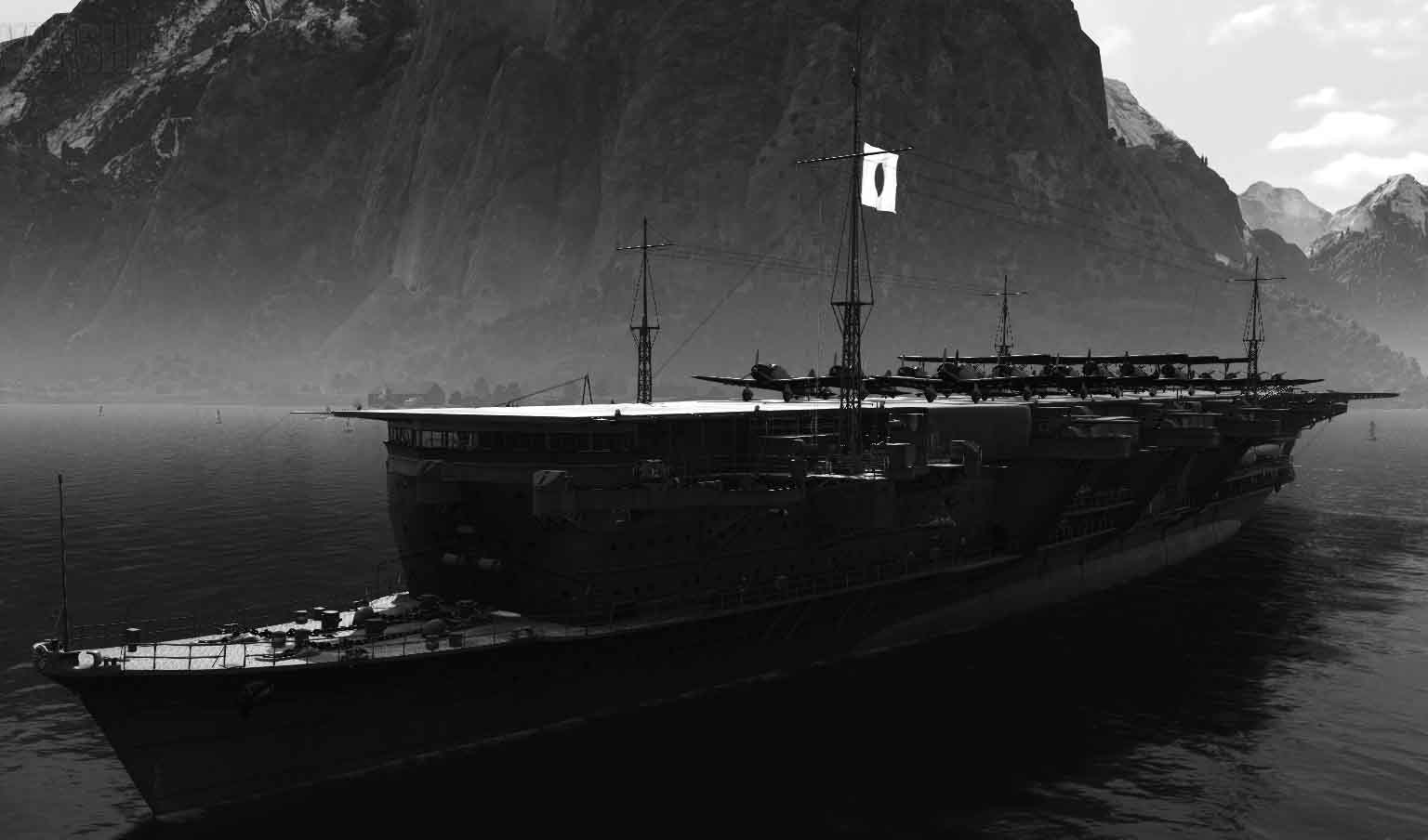


 Latest Facebook Entry -
Latest Facebook Entry -  X(Tweeter) Naval Encyclopedia's deck archive
X(Tweeter) Naval Encyclopedia's deck archive Instagram (@navalencyc)
Instagram (@navalencyc)





 French Navy
French Navy Royal Navy
Royal Navy Russian Navy
Russian Navy Armada Espanola
Armada Espanola Austrian Navy
Austrian Navy K.u.K. Kriegsmarine
K.u.K. Kriegsmarine Dansk Marine
Dansk Marine Nautiko Hellenon
Nautiko Hellenon Koninklije Marine 1870
Koninklije Marine 1870 Marinha do Brasil
Marinha do Brasil Osmanlı Donanması
Osmanlı Donanması Marina Do Peru
Marina Do Peru Marinha do Portugal
Marinha do Portugal Regia Marina 1870
Regia Marina 1870 Nihhon Kaigun 1870
Nihhon Kaigun 1870 Preußische Marine 1870
Preußische Marine 1870 Russkiy Flot 1870
Russkiy Flot 1870 Svenska marinen
Svenska marinen Søværnet
Søværnet Union Navy
Union Navy Confederate Navy
Confederate Navy Armada de Argentina
Armada de Argentina Imperial Chinese Navy
Imperial Chinese Navy Marinha do Portugal
Marinha do Portugal Mexico
Mexico Kaiserliche Marine
Kaiserliche Marine 1898 US Navy
1898 US Navy Sovietskiy Flot
Sovietskiy Flot Royal Canadian Navy
Royal Canadian Navy Royal Australian Navy
Royal Australian Navy RNZN Fleet
RNZN Fleet Chinese Navy 1937
Chinese Navy 1937 Kriegsmarine
Kriegsmarine Chilean Navy
Chilean Navy Danish Navy
Danish Navy Finnish Navy
Finnish Navy Hellenic Navy
Hellenic Navy Polish Navy
Polish Navy Romanian Navy
Romanian Navy Turkish Navy
Turkish Navy Royal Yugoslav Navy
Royal Yugoslav Navy Royal Thai Navy
Royal Thai Navy Minor Navies
Minor Navies Albania
Albania Austria
Austria Belgium
Belgium Columbia
Columbia Costa Rica
Costa Rica Cuba
Cuba Czechoslovakia
Czechoslovakia Dominican Republic
Dominican Republic Haiti
Haiti Hungary
Hungary Honduras
Honduras Estonia
Estonia Iceland
Iceland Eire
Eire Equador
Equador Iran
Iran Iraq
Iraq Latvia
Latvia Liberia
Liberia Lithuania
Lithuania Mandchukuo
Mandchukuo Morocco
Morocco Nicaragua
Nicaragua Persia
Persia San Salvador
San Salvador Sarawak
Sarawak Uruguay
Uruguay Venezuela
Venezuela Zanzibar
Zanzibar Warsaw Pact Navies
Warsaw Pact Navies Bulgaria
Bulgaria Hungary
Hungary

 Bundesmarine
Bundesmarine Dutch Navy
Dutch Navy Hellenic Navy
Hellenic Navy Marina Militare
Marina Militare Yugoslav Navy
Yugoslav Navy Chinese Navy
Chinese Navy Indian Navy
Indian Navy Indonesian Navy
Indonesian Navy JMSDF
JMSDF North Korean Navy
North Korean Navy Pakistani Navy
Pakistani Navy Philippines Navy
Philippines Navy ROKN
ROKN Rep. of Singapore Navy
Rep. of Singapore Navy Taiwanese Navy
Taiwanese Navy IDF Navy
IDF Navy Saudi Navy
Saudi Navy Royal New Zealand Navy
Royal New Zealand Navy Egyptian Navy
Egyptian Navy South African Navy
South African Navy






























 Ukrainian Navy
Ukrainian Navy dbodesign
dbodesign
The planned displacement of 8,000 tons was ludicrously inadequate for a fleet carrier.